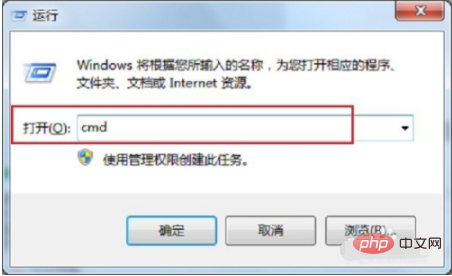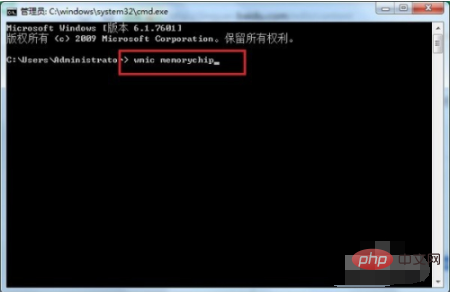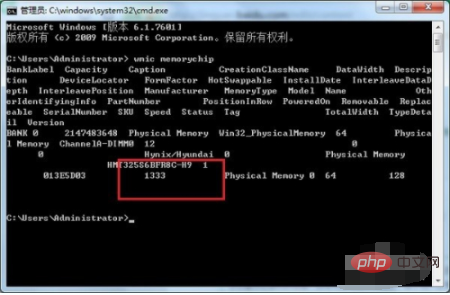How to check the frequency of a memory stick
How to check the frequency of the memory module: First press the [win R] key to open the run, and enter [cmd] during the run; then enter the command prompt and enter [wmic memorychip]; finally press the Enter key. Can.

How to check the frequency of the memory module:
1. In the first step, press the "win R" key to open the run , enter "cmd" when running, as shown in the following figure:

2. In the second step, enter the command prompt and enter "wmic memorychip", as shown in the following figure :

3. In the third step, press the Enter key. We can see the frequency of the memory module, as shown in the figure below:

The above is the detailed content of How to check the frequency of a memory stick. For more information, please follow other related articles on the PHP Chinese website!

Hot AI Tools

Undresser.AI Undress
AI-powered app for creating realistic nude photos

AI Clothes Remover
Online AI tool for removing clothes from photos.

Undress AI Tool
Undress images for free

Clothoff.io
AI clothes remover

Video Face Swap
Swap faces in any video effortlessly with our completely free AI face swap tool!

Hot Article

Hot Tools

Notepad++7.3.1
Easy-to-use and free code editor

SublimeText3 Chinese version
Chinese version, very easy to use

Zend Studio 13.0.1
Powerful PHP integrated development environment

Dreamweaver CS6
Visual web development tools

SublimeText3 Mac version
God-level code editing software (SublimeText3)

Hot Topics
 Can the computer be turned on if the memory module is broken?
Feb 20, 2023 pm 02:10 PM
Can the computer be turned on if the memory module is broken?
Feb 20, 2023 pm 02:10 PM
If the memory module is broken, the computer cannot be turned on. If the memory module is broken, there will be two situations: 1. The computer cannot be turned on normally. This situation is a very common type of memory failure. Basically, it is manifested as the chassis issuing a sound when turning on the computer. Didi's warning sound, unable to enter the system or the display does not light up; 2. Frequent blue screens or crashes. A blue screen appears after booting. Most of them are memory errors that cannot be recognized.
 Which has a greater impact on performance, memory frequency or timing?
Feb 19, 2024 am 08:58 AM
Which has a greater impact on performance, memory frequency or timing?
Feb 19, 2024 am 08:58 AM
Memory is one of the most important components in the computer, and it has a significant impact on the performance and stability of the computer. When choosing memory, people tend to focus on two important parameters, namely timing and frequency. So, for memory performance, which is more important, timing or frequency? First, let's understand the concepts of timing and frequency. Timing refers to the time interval required for a memory chip to receive and process data. It is usually represented by a CL value (CASLatency). The smaller the CL value, the faster the memory processing speed. The frequency is within
 Supporting the new generation of CAMM2 memory modules, MSI and ASRock exhibited special Intel motherboards
Jun 07, 2024 am 11:23 AM
Supporting the new generation of CAMM2 memory modules, MSI and ASRock exhibited special Intel motherboards
Jun 07, 2024 am 11:23 AM
According to news from this site on June 4, based on reports from Taiwanese media BenchLife.info and updates from X platform user @wagipon, both MSI and ASRock exhibited special Intel motherboards that support CAMM2 memory modules at the 2024 Taipei International Computer Show. Among them, MSI brought the previously warmed-up Z790PROJECTZEROPLUS (CAMM2) motherboard, which is equipped with the FURYImpactDDR5CAMM2 prototype memory module from Kingston. ▲Picture source BenchLife.info MSI stated that the DDR5CAMM2 memory module can support up to 128GB capacity, and a single module can achieve dual channels, which can reduce compatibility issues (Note from this site: Even if only the batch number is different, the traditional
 Up to 6800CL34, ADATA XPG launches ASUS TUF GAMING co-branded Longyao D300G memory module
Jun 20, 2024 pm 08:23 PM
Up to 6800CL34, ADATA XPG launches ASUS TUF GAMING co-branded Longyao D300G memory module
Jun 20, 2024 pm 08:23 PM
According to news from this website on June 20, XPG, the gaming hardware brand of ADATA, recently launched the Longyao D300GTUFGAMING co-branded DDR5U-DIMM memory module, which is available in black and white. This series of co-branded memory modules is based on the original Longyao D300G, and the cooling vest is decorated with ASUS TUFGAMING "E-Sports Agent" themed text and graphics. According to ADATA, the Longyao D300GTUFGAMING co-branded memory module is specially designed for FPS game enthusiasts. It has excellent appearance and high performance, meeting the stringent requirements of FPS games for hardware stability. Longyao D300GTUFGAMING co-branded memory is 40mm high, available in 6000CL30, 6400CL32 and 68
 ASUS TUF Z790 Plus is compatible with ASUS MCP79 memory frequency
Jan 03, 2024 pm 04:18 PM
ASUS TUF Z790 Plus is compatible with ASUS MCP79 memory frequency
Jan 03, 2024 pm 04:18 PM
ASUS tufz790plus supports memory frequency. ASUS TUFZ790-PLUS motherboard is a high-performance motherboard that supports dual-channel DDR4 memory and supports up to 64GB of memory. Its memory frequency is very powerful, up to 4800MHz. Specific supported memory frequencies include 2133MHz, 2400MHz, 2666MHz, 2800MHz, 3000MHz, 3200MHz, 3600MHz, 3733MHz, 3866MHz, 4000MHz, 4133MHz, 4266MHz, 4400MHz, 4533MHz, 4600MHz, 4733MHz and 4800MHz. Whether it is daily use or high performance needs
 Does Thinkbook 15P support memory expansion?
Jan 18, 2024 am 09:06 AM
Does Thinkbook 15P support memory expansion?
Jan 18, 2024 am 09:06 AM
After buying the thinkbook15P notebook, many users find that it has only one memory, so they are worried that it will not be used enough. They want to add a memory stick but are not sure whether it can be installed. In fact, there is no problem and it can be installed according to needs. Can memory modules be added to thinkbook15P? Answer: Memory modules can be added to thinkbook15P. thinkbook15P has a single 16g memory, so you can add 16g or 32g without any problem. Introduction to thinkbook15P performance expansion: 1. Thinkbook15P runs very fast, and the response is not laggy. It can be supported by wifii6, and the effect is good. 2. It will not have any impact when used, and the heat dissipation is also good.
 Can memory sticks of different brands be mixed?
Dec 18, 2023 pm 04:39 PM
Can memory sticks of different brands be mixed?
Dec 18, 2023 pm 04:39 PM
Memory modules of different brands can generally be mixed. As long as their parameters such as frequency, capacity and interface are the same, they can be mixed. Different brands of memory modules may have differences in production processes and quality. Mixing them may cause unstable computer performance or other problems. Therefore, when choosing a memory module, it is recommended to choose a memory module of the same brand and model to ensure the stability and performance of the computer.
 How to check the frequency of ddr4
Feb 01, 2024 am 09:42 AM
How to check the frequency of ddr4
Feb 01, 2024 am 09:42 AM
The biggest impact of ddr4 memory sticks on computers is frequency, and many users don't know how to check the frequency. In fact, you can check it through the CPU software, and all aspects of information are displayed in great detail. How to check the frequency of ddr4: 1. You must first check it through the software. You can use CPU-z to check it. 2. After it is done, open it and click "Memory". 3. At this time, you can see the "frequency" below.





